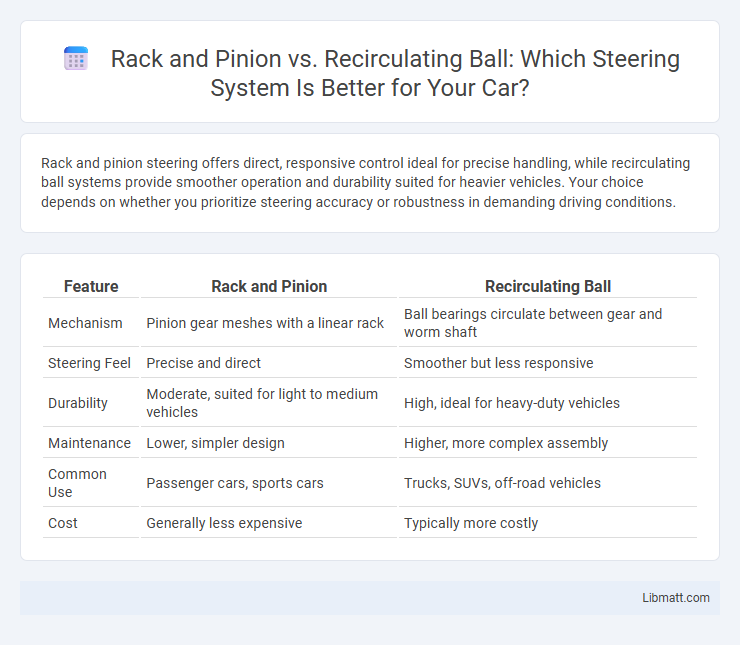Rack and pinion steering offers direct, responsive control ideal for precise handling, while recirculating ball systems provide smoother operation and durability suited for heavier vehicles. Your choice depends on whether you prioritize steering accuracy or robustness in demanding driving conditions.
Table of Comparison
| Feature | Rack and Pinion | Recirculating Ball |
|---|---|---|
| Mechanism | Pinion gear meshes with a linear rack | Ball bearings circulate between gear and worm shaft |
| Steering Feel | Precise and direct | Smoother but less responsive |
| Durability | Moderate, suited for light to medium vehicles | High, ideal for heavy-duty vehicles |
| Maintenance | Lower, simpler design | Higher, more complex assembly |
| Common Use | Passenger cars, sports cars | Trucks, SUVs, off-road vehicles |
| Cost | Generally less expensive | Typically more costly |
Introduction to Steering Mechanisms
Rack and pinion steering offers direct and responsive control through a straightforward gear system, ideal for precision driving. The recirculating ball mechanism employs a series of ball bearings to reduce friction, providing durability and smoother operation in heavy-duty vehicles. Your choice depends on the desired balance between steering feel and mechanical robustness.
Overview: Rack and Pinion Steering
Rack and pinion steering offers direct, precise control by converting rotational motion of the steering wheel into linear motion via a gear set engaging a toothed rack. This system is widely used in modern passenger vehicles due to its simplicity, responsiveness, and reduced mechanical play. Its design enables quicker steering response and improved road feedback compared to recirculating ball steering, which uses ball bearings within a worm gear mechanism to reduce friction but often results in less tactile feedback.
Overview: Recirculating Ball Steering
Recirculating ball steering features a worm gear mechanism with ball bearings that reduce friction and provide smooth, precise control in heavy-duty vehicles. Unlike rack and pinion systems, it offers improved durability and better handling under high loads, making it ideal for trucks and large SUVs. You will benefit from enhanced steering stability and reduced wear in demanding driving conditions.
Key Components and Design Differences
Rack and pinion steering systems consist of a straight gear rack and a circular pinion gear that mesh directly to convert rotational motion into linear motion, offering precise and responsive control. Recirculating ball systems feature a worm gear, a sector gear, and ball bearings that reduce friction by circulating balls within the gear assembly, resulting in smoother but less direct steering. The direct mesh in rack and pinion provides sharper feedback and simpler design, whereas recirculating ball's complex gear mechanism is suited for heavier vehicles requiring greater torque.
Steering Response and Precision Comparison
Rack and pinion steering systems offer superior steering response and precision due to their direct mechanical connection between the steering wheel and the wheels, minimizing play and providing immediate feedback. Recirculating ball systems, while durable and better suited for heavy vehicles, tend to have more mechanical complexity and backlash, resulting in less precise steering and slower response times. The reduced friction and simpler design of rack and pinion make it the preferred choice for performance vehicles requiring sharp handling and accurate control.
Durability and Maintenance Requirements
Rack and pinion steering systems generally exhibit lower durability under heavy load conditions due to direct gear engagement but require minimal maintenance, making them ideal for light to moderate use. Recirculating ball steering systems feature enhanced durability and load capacity through the use of ball bearings that reduce friction and wear, yet they demand more frequent inspections and occasional grease replenishment. The maintenance complexity and longevity of recirculating ball systems offset their robustness, whereas rack and pinion setups prioritize simplicity and ease of upkeep.
Performance in Different Vehicle Types
Rack and pinion steering systems deliver precise and responsive control, making them ideal for passenger cars and sports vehicles that require sharp handling and quick feedback. Recirculating ball steering systems provide enhanced durability and smoother operation under heavy loads, which suits trucks and SUVs designed for towing and off-road driving. Performance differences arise from the rack and pinion's direct mechanical link versus the recirculating ball's gear and bearing arrangement, affecting steering feel and reliability based on vehicle weight and use.
Common Issues and Troubleshooting
Rack and pinion steering systems often face issues like worn-out tie rod ends, fluid leaks, and steering wheel play, which you can troubleshoot by inspecting seals, replacing damaged components, and checking power steering fluid levels. Recirculating ball steering commonly experiences problems such as excessive steering effort, loose steering feel, and noise caused by worn ball bearings or gearbox wear; addressing these involves adjusting the steering box, lubricating moving parts, or replacing bearings. Understanding these symptoms and maintenance techniques ensures more precise and reliable steering performance in your vehicle.
Cost Considerations: Installation and Repairs
Rack and pinion steering systems typically have lower installation and repair costs due to their simpler design and fewer moving parts compared to recirculating ball systems. Recirculating ball steering mechanisms involve more complex components, which can increase expenses for parts and labor during repairs. Your choice between the two will impact long-term maintenance costs, with rack and pinion offering more economical options for installation and servicing.
Choosing the Right System: Factors to Consider
When choosing between rack and pinion and recirculating ball steering systems, consider factors such as precision, durability, and vehicle type. Rack and pinion systems offer more responsive handling and are ideal for passenger cars requiring precise steering control, while recirculating ball systems provide greater durability and load handling, making them suitable for trucks and heavy-duty vehicles. Your choice should align with your vehicle's driving needs, maintenance preferences, and overall steering performance expectations.
rack and pinion vs recirculating ball Infographic

 libmatt.com
libmatt.com